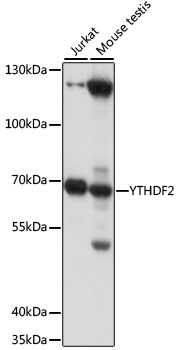-
Product Name
YTHDF2 Polyclonal Antibody
- Documents
-
Description
Polyclonal antibody to YTHDF2
-
Tested applications
WB, IF
-
Species reactivity
Human, Mouse, Rat
-
Alternative names
YTHDF2 antibody; CAHL antibody; HGRG8 antibody; NY-REN-2 antibody; YTH domain-containing family protein 2 antibody
-
Isotype
Rabbit IgG
-
Preparation
Antigen: Recombinant fusion protein containing a sequence corresponding to amino acids 1-200 of human YTHDF2 (NP_057342.2).
-
Clonality
Polyclonal
-
Formulation
PBS with 0.02% sodium azide, 50% glycerol, pH7.3.
-
Storage instructions
Store at -20℃. Avoid freeze / thaw cycles.
-
Applications
WB 1:500 - 1:2000
IF 1:50 - 1:100 -
Validations

Western blot - YTHDF2 Polyclonal Antibody
Western blot analysis of extracts of various cell lines, using YTHDF2 antibody at 1:1000 dilution.Secondary antibody: HRP Goat Anti-Rabbit IgG (H+L) at 1:10000 dilution.Lysates/proteins: 25ug per lane.Blocking buffer: 3% nonfat dry milk in TBST.Detection: ECL Basic Kit .Exposure time: 3s.
-
Background
Specifically recognizes and binds N6-methyladenosine (m6A)-containing RNAs, and regulates mRNA stability. M6A is a modification present at internal sites of mRNAs and some non-coding RNAs and plays a role in mRNA stability and processing. Acts as a regulator of mRNA stability: binding to m6A-containing mRNAs results in the localization to mRNA decay sites, such as processing bodies (P-bodies), leading to mRNA degradation. Required maternally to regulate oocyte maturation: probably acts by binding to m6A-containing mRNAs, thereby regulating maternal transcript dosage during oocyte maturation, which is essential for the competence of oocytes to sustain early zygotic development (By similarity). Also involved in haematopoietic stem cells specification: acts by binding to m6A-containing mRNAs, leading to decrease Notch dignaling and promote endothelial to haematopoietic transition (By similarity). Also acts as a promoter of cap-independent mRNA translation following heat shock stress: upon stress, relocalizes to the nucleus and specifically binds mRNAs with some m6A methylation mark at their 5'-UTR, protecting demethylation of mRNAs by FTO, thereby promoting cap-independent mRNA translation. May inhibit replication of kaposis sarcoma-associated herpesvirus (KSHV); its role is however unclear and additional evidences are needed to confirm such results.; (Microbial infection) Promotes viral gene expression and replication of polyomavirus SV40: acts by binding to N6-methyladenosine (m6A)-containing viral RNAs.; (Microbial infection) Promotes viral gene expression and virion production of kaposis sarcoma-associated herpesvirus (KSHV) at some stage of the KSHV life cycle (in iSLK.219 and iSLK.BAC16 cells). Acts by binding to N6-methyladenosine (m6A)-containing viral RNAs.
Related Products / Services
Please note: All products are "FOR RESEARCH USE ONLY AND ARE NOT INTENDED FOR DIAGNOSTIC OR THERAPEUTIC USE"
